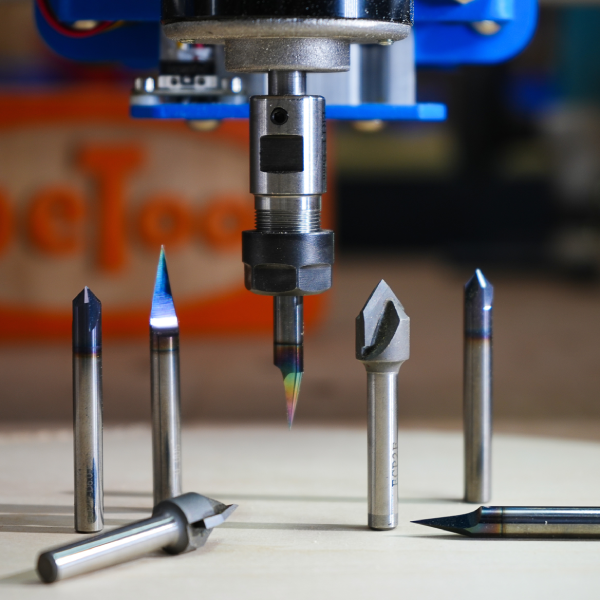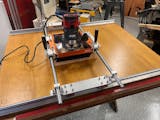Get Professional Results with Tapered End Mills
End mills are the key components of a milling machine. The larger the end mill, the better is its performance. They help cut through large pieces of material with ease and produce precise cuts.
End mills come in different sizes with different cutting edges to meet the specific requirements of a particular application. If you are looking to explore the variety of end mills available in the market and their applications, this blog is for you. In this blog, we will discuss how tapered end mills can be used in various applications and what benefits they offer over standard end mills.
What Are Tapered End Mills?
Tapered end mills are cutting tools that feature a conical cutting head and are used for side milling, contouring, and machining angled slots. They are available at different prices, depending on the material used and their quality. Tapered end mills can be made from carbide or cobalt steel, with each type having its specific advantages. Some benefits of tapered end mills include higher feeds and speeds capability, improved tool strength, and increased productivity. However, there are certain requirements that they may not be suitable for. One of the advantages of tapered end mills is the flutes on the cutting head that help carry away chips from the work-piece, preventing damage. With these tools, you can get professional results and achieve precision in your work. If you're looking for high-quality cutting tools that can help you perform various machining tasks with ease, then consider using tapered end mills.

Tapered Reach
Tapered end mills are a tool commonly used in milling operations. They are made of high-speed steel and have a conical cutting head that is wider at the base than at the tip. This unique shape allows tapered end mills to be used for a wide range of applications, including milling operations in deeper cavities and at harder angles. Tapered reach end mills have several benefits, including increased tool strength, reduced tool deflection, and higher productivity. However, they may not always be suitable for certain situations. It is important to find a tapered end mill that fits the specific needs of your project. Flutes on the cutting head of tapered end mills carry chips away from the work-piece, preventing damage and ensuring a clean finish. Tapered end mills come in a range of prices that can fit into any budget. By using a tapered end mill, you can achieve professional results in your milling operations.
Tapered Length of Cut
Tapered end mills are cutting tools with a conical-shaped cutting head that is wider at the base than the tip, making them ideal for angled surface machining. These tools have flutes on the cutting head that prevent damage to the work-piece or end mill by carrying chips away. Compared to straight reach cutting tools, tapered end mills offer increased strength and reduced deflection, resulting in a smoother and more precise cutting experience. However, it's important to choose the right length of cut for optimal performance in clearances. Price ranges for tapered end mills vary, but investing in the largest possible tapered reach can provide the best performance benefits. With the right tapered end mill, you can achieve professional results in your machining projects.
Benefits of using tapered end mills
Tapered end mills are a powerful tool for anyone who wants to achieve professional results in their machining operations. They have a higher price range compared to other end mills, but their benefits make them worth the investment. Tapered end mills are used in a wide range of applications, including remaining conical holes and other machining operations that need an angled surface. They also come in various taper angles, allowing you to mill parts with mating tapered or angled surfaces. The advantages of using tapered end mills are numerous. They have a greater tool strength, lesser tool deflection, higher capability of feeds and speeds, and better finish with low chatter, which increases productivity. However, tapered end mills may not be feasible in specific requirements such as walls with slight angles, where a straight tool may work better. Overall, if you want to achieve top-notch results with your machining operations, a tapered end mill is a must-have tool for your toolkit.
PRODUCTION ENHANCEMENTS
Tapered end mills are a popular choice for machining operations that require an angled surface. They come in a variety of price points, from the highest to the lowest cost options. The proper selection of tapered end mills can improve production results by almost threefold. Tapered end mills are made from high-quality materials for top performance. They offer a number of benefits over traditional end mills, including increased tool strength, less chatter, and better finish. However, it's important to note that tapered reach end mills may not be suitable for certain situations. Using tapered end mills can increase productivity and are capable of higher speeds and feeds. They are useful for a variety of machining operations and are a popular choice for professionals who want to achieve professional results. With tapered end mills, machining becomes easier, more efficient, and produces higher quality results.
Types of tapered end mills
Tapered end mills, which come in various types, are efficient and productive tools for side milling, angled slot machining, and for creating parts with mating tapered or angled surfaces. Cobalt steel, carbide tapered ball end mills, and carbide tapered square end mills are among the most popular types to choose from. The taper angle, which is measured in degrees, allows for versatile milling that works well with both small and large projects. The price of tapered end mills varies depending on the supplier, and there are many options available to fit different budgets. Additionally, tapered end mills have flutes on the cutting head to prevent damage to the end mill or workpiece while carrying chips away. With the use of tapered end mills, professional results can be achieved with precision and accuracy.
Miniature End Mills-Tapered-Ball
Tapered end mills are a must-have for any professional looking to achieve precise and accurate results in their machining projects. There are several types of tapered end mills available, including cobalt steel and carbide options. They feature varying diameters and advanced variable geometries for improved performance, allowing for easier and more efficient material removal. When it comes to deep cavity profiling or finishing, the miniature end mills with a 2掳 tapered neck design are ideal. This design allows for excellent chip evacuation and improved flute engagement, resulting in a better finish. Additionally, the long length design of tapered end mills optimizes accuracy in deep cavity machining. For those looking for professional results in their machining projects, tapered end mills are an essential tool. With their advanced designs and multiple options available, they can help to improve performance and achieve precise results.
Miniature End Mills-Ball-Tapered Reach (Clearance Cutters)
Tapered end mills are a popular choice for professionals looking to achieve superior results. These end mills have a wider base than the tip, which allows for milling in deeper cavities and increased strength. Additionally, tapered end mills are available in a variety of designs, including miniature end mills with tapered necks, tapered reach end mills, and ball-tapered reach clearance cutters. Miniature end mills with tapered necks are particularly useful for deep cavity profiling, as they provide maximum wall clearance. Tapered reach end mills, on the other hand, offer advantages such as increased tool strength and higher speeds and feeds capability. It's worth noting, however, that tapered end mills also have their limitations. For example, tapered reach end mills can have reduced clearance, and may not be suitable for certain milling applications. At Valley Tool Inc., we offer a range of custom tool options for tapered end mills that can be designed with unmatched accuracy and precision. Whether you're looking for a standard or a custom tool, we can help you select the right tapered end mill for your specific needs.
Miniature End Mills-Tapered-Square
Tapered end mills are an essential tool for achieving professional results in machining work. There are various types of tapered end mills available, including miniature end mills that come in tapered square shapes. These miniature end mills are available in both cobalt steel and carbide and are ideal for accurate deep cavity machining. Conical tapered carbide end mills are another available option, and they come in varying diameters, lengths, and end options. These end mills are designed to improve finish and chip evacuation during machining processes. Additionally, miniature square tapered end mills with a 2掳 tapered neck are available. These end mills are designed to minimize deflection and maximize wall clearance. Overall, tapered end mills have become an industry-wide standard bearer with advanced, variable geometries that reduce harmonics, increase speeds and feeds, and improve cycle times. This makes them ideal for achieving professional results in machining work.
Miniature End Mills-Square-Tapered Reach (Clearance Cutters)
Tapered end mills are a great choice for professionals who want to achieve high-quality results in their milling operations. There are several types of tapered end mills available, including miniature end mills with tapered reach. Miniature end mills with tapered reach are designed to provide deep cavity profiling with minimized deflection and maximized wall clearance. They offer reduced tool deflection and better finishes, making them an excellent choice for professional applications. Tapered end mills are wider at the base than the tip, offering increased strength over straight reach cutting tools. They are suitable for milling operations in deeper cavities and provide increased productivity. However, they also have reduced clearance and may not always be suitable for certain situations. One specific type of miniature end mill with tapered reach is the clearance cutter. This tool has a square-tapered reach and is perfect for removing material from deep cavities while leaving a smooth and accurate finish. By using tapered end mills, professionals can achieve exceptional results with their milling operations.
Examples of applications for tapered end mills
Tapered end mills are a versatile tool, and their various applications make them an essential tool for metalworking. They are used for machining angled slots, side milling, contouring, reaming conical holes, and creating angled surfaces. Available in high-speed steel, cobalt steel, and carbide, tapered end mills are engineered to precision for consistent performance. They feature a variety of taper angles, measured in degrees, to cater to specific needs. Tapered end mills are designed to carry chips away from the workpiece, reducing potential damage. For tool and die work and other machining operations that require an angled surface, using tapered end mills can give you professional and accurate results.
How to choose the right tapered end mill?
Selecting the right tapered end mill isn't as simple as just choosing one from the shelf. Consider the price of different models and select the one which meets both your budget and needs. It is also important to choose an end mill based on the material to be cut and the finishing requirements. The larger tapered reach will ensure optimal performance for longer cutting time. Tapered end mills in general provide many benefits, including greater strength and productivity. However, straight end mills might be more suitable for certain requirements, like angled walls. Choose the right end mill for your application and use it skillfully to achieve professional results effortlessly.
Conclusion
The tapered end mill is a versatile cutter that offers a range of benefits to the user. They are ideal for high-production cutting applications where accuracy and surface finish are crucial. They can be used in a wide range of materials, from plastics to metals, and can be easily adapted to different machine setups. Take a look at some real-life examples of applications for tapered end mills here.

Frequently Asked Questions
What types of applications can be performed with a tapered end mill?
When it comes to applications that tapered end mills can be used for, here are a few: - Side milling: This is done to create valleys or recesses in a part, by removing material from one side of the part. - Contouring: This is used to smooth out or modify the shape of a surface. - Machining angled slots: Slots that are at an angle can be machined more easily with a tapered end mill because the wider base allows the tool to move deeper into the slot while the tip of the tool makes contact with the wall at only a small point. Milling curved surfaces: A tapered end mill is better suited for machining curves than a straight tool because it has greater strength and less deflection. It can also handle higher feeds and speeds, resulting in a better finish. - Chip evacuation: Tapered end mills are often more effective at evacuating chips than straight tools, due to their conical design.
What are the limitations of tapered end mills?
There are a few limitations of tapered end mills that you should be aware of before making a purchase. First, the price point for tapered end mills is usually higher than for straight end mills. Additionally, due to the design of tapered end mills, they may not be suitable for certain applications. For example, if you need a mill that can handle a high degree of wear and tear, then a straight end mill may be a better option for you. The second limitation of tapered end mills is that they have greater tool strength and lesser tool deflection than straight end mills. This means that they can handle tougher materials with relative ease and don't require frequent adjustment or replacement of tools. Lastly, tapered end mills are available in different materials such as cobalt steel and carbide. This means that you can choose the right type of mill for your specific application.
How do I choose the right tapered end mill for my application?
When choosing the right tapered end mill for your application, you'll want to consider both high and low priced models. Tapered end mills are useful in a wide range of applications, including but not limited to plastics, composites, wood, and metals. They offer increased strength and milling capabilities, which makes them a great choice for specific applications. However, tapered end mills have pros and cons compared to straight end mills. The main con is that they can be harder to control when milling complex materials or when doing precision work. On the other hand, straight end mills may require more lubrication and tend to wear faster. When selecting between tapered and straight end mills, it is important to consider the specific requirements of your application.






